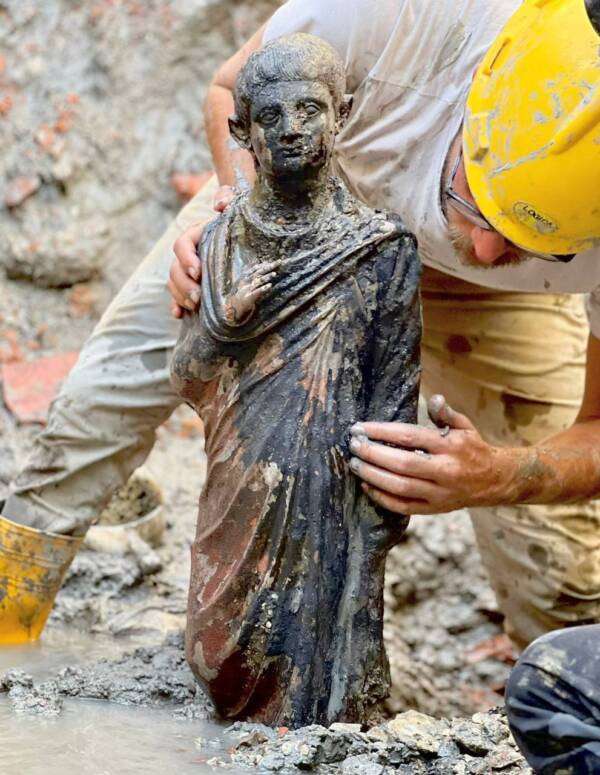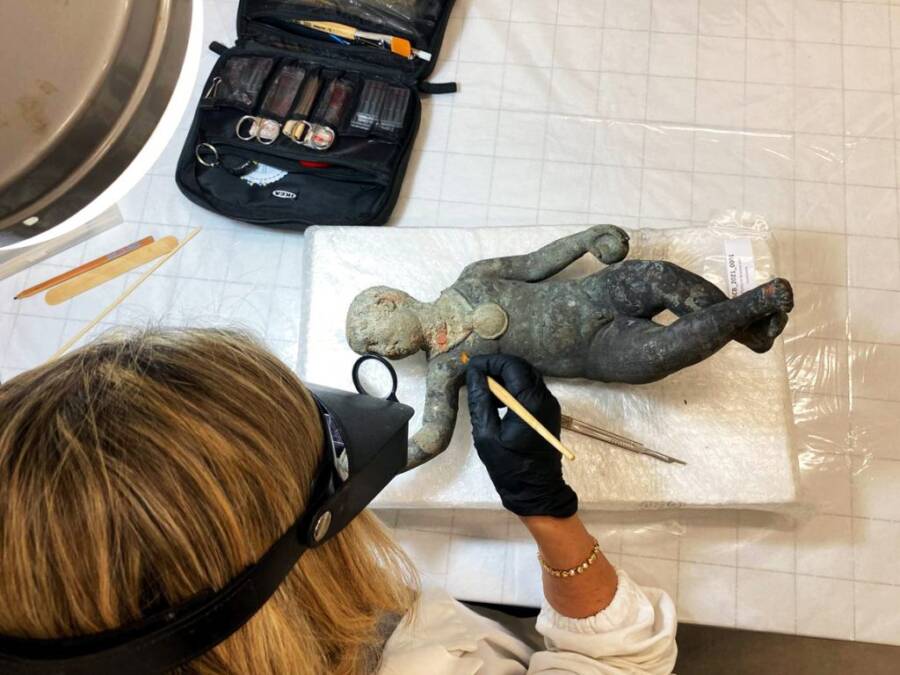Though these statues discovered in San Casciano dei Bagni are around 2,300 years old, they've remained shockingly well preserved beneath layers of mud.

Jacopo Tabolli/Universita per Stranieri di SienaThe trove of statues is considered one of the most “significant discoveries” of bronzes in Italian history.
While excavating the site of an ancient spa in San Casciano dei Bagni near Siena, Italy, archaeologists uncovered two dozen well-preserved bronze statues. Experts rave that the bronzes are an impressive discovery and illuminate a tumultuous time in Italian history.
The excavations at the ancient Etruscan spa, which have taken place since 2019 under the direction of archaeologist Jacopo Tabolli, assistant professor at the University for Foreigners in Siena, unearthed 24 large statues, a handful of small figurines, and around 5,000 bronze, silver, and gold coins.
The bronze statues include depictions of the Roman god Apollo and Hygieia, the goddess of health, as well as other Greco-Roman deities. The smaller figurines include a hand holding money, a pair of breasts, a penis, and a swaddled child.
“It is a very significant, exceptional finding,” Tabolli told Reuters. Adding that the statues probably once decorated the spa before they were submerged in the waters as some kind of ritual more than 1,500 years ago, he said: “You give to the water because you hope that the water gives something back to you.”
Well-preserved and beautiful to behold, the statues are more than an artistic treasure, however. They also tell an important story about the transitionary period between Etruscan and Roman rule in Italy.

Italian Ministry of CultureThe statues are more than 2,000 years old and were likely submerged between the first and fifth centuries C.E.
As Smithsonian magazine explains, the statues date back to between the third century B.C.E. and the first century C.E. Then, Romans were fighting to take over Etruscan territory. A series of bloody battles eventually led to Roman rule, and the Romans then sought to dismantle Etruscan culture.
But the originally Etruscan spa bears marks of both cultures, suggesting that the transitionary period from Etruscan to Roman rule was complicated.
“Even in historical epochs in which the most awful conflicts were raging outside, inside these pools and on these altars the two worlds, the Etruscan and Roman ones, appear to have coexisted without problems,” Tabolli told the Guardian. To Smithsonian he added: “This discovery rewrites the history of ancient art. Here, Etruscans and Romans prayed together.”
The Etruscans lived largely in Tuscany and Umbria for around five centuries before the rise of the Roman Republic. Etruscans — and then Romans — would have visited the spas for health reasons.
“This water was considered great for the liver, for treating facial pain, for helping with fertility,” Tabolli told the Guardian. “There was a lot of ritualistic practice connected to pregnancy, so the theme of natality was extremely important. But this was definitely not drinkable water, as it’s poisonous.”
Romans made the spas more opulent and they became a popular health destination for Roman emperors like Augustus. The spas were used until around the fifth century C.E. when Christian rules against public bathing shut them down. The spa wasn’t destroyed, however — just closed. Ancient people covered the pools with stone pillars, leaving the bronze statues in the water below.

Italian Ministry of CultureThe bronze statues tell a fascinating tale about the transition from Etruscan to Roman culture.
For now, the artifacts discovered at the spa will be kept in a 16th-century building owned by the culture ministry in San Casciano. The ancient spas will also be developed into an archaeological park and that excavations at the site will continue next spring.
The discovery has delighted locals and government ministers alike. Gennaro Sangiuliano, the Italian minister of culture, called the bronze statues an “exceptional discovery,” according to The Guardian, one that underlines the fact that “Italy is a country full of huge and unique treasures.”
Italians, too, who have long enjoyed the modern-day spa built next to the ancient one, are pleased with the discovery. And locals of San Casciano dei Bagni are hopeful that the find will increase tourism to their struggling town.
“It’s as if we found oil,” the town’s mayor, Agnese Carletti, told the Guardian. “Maybe all these gods are now bringing us some good fortune.”
After reading about the stunning bronze statues found in a Tuscan spa, see how a “perfectly preserved” Roman shipwreck was discovered in Mallorca, Spain. Then, see some of the most famous statues around the world.





